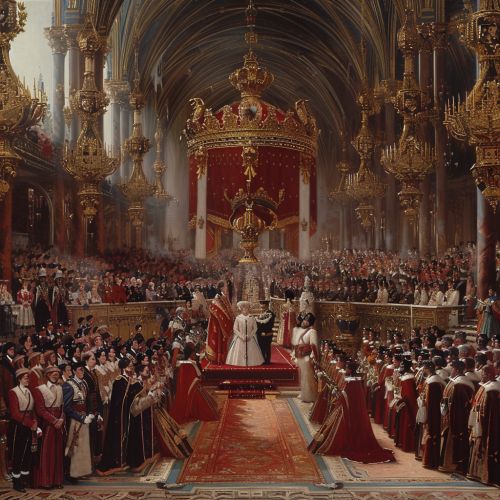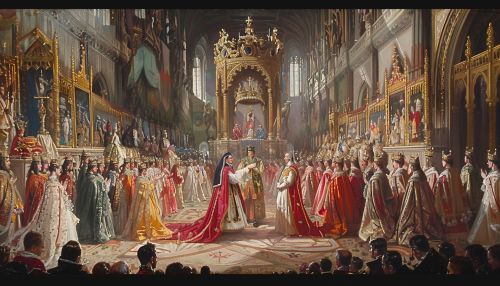English Crown
Introduction
The English Crown, often referred to simply as "the Crown," represents the legal embodiment of executive, legislative, and judicial governance in the United Kingdom. The concept of the Crown has evolved over centuries, encompassing a complex amalgamation of historical, political, and legal elements. This article delves into the intricate details of the English Crown, exploring its origins, functions, and significance within the British constitutional framework.
Historical Origins
Early Monarchy
The origins of the English Crown can be traced back to the early medieval period. The Anglo-Saxon kings, such as Alfred the Great, laid the foundations for the English monarchy. The Norman Conquest of 1066, led by William the Conqueror, significantly transformed the nature of the Crown, introducing feudalism and centralizing royal authority.
Plantagenet and Tudor Dynasties
The Plantagenet dynasty, beginning with Henry II, saw the Crown's power expand through legal reforms and territorial acquisitions. The Magna Carta of 1215, signed by King John, was a pivotal moment, establishing the principle that the monarch's power was not absolute. The Tudor dynasty, particularly under Henry VIII and Elizabeth I, further consolidated the Crown's authority, navigating religious upheavals and establishing a strong centralized state.
Stuart and Hanoverian Periods
The Stuart dynasty faced significant challenges, including the English Civil War and the Glorious Revolution. The latter event in 1688 resulted in the Bill of Rights 1689, which limited the powers of the Crown and laid the groundwork for a constitutional monarchy. The Hanoverian period saw the further development of parliamentary sovereignty, with monarchs like George III playing a more ceremonial role.
Constitutional Role
The Crown in Parliament
The phrase "the Crown in Parliament" encapsulates the constitutional principle that the Crown and Parliament together constitute the supreme authority in the UK. This concept underscores the collaborative nature of governance, where the monarch's powers are exercised through elected representatives. The Royal Assent is a key function, where the monarch formally approves legislation passed by Parliament.
Executive Functions
The Crown's executive functions are carried out by the Prime Minister and the Cabinet, who act on behalf of the monarch. This includes the appointment of ministers, the conduct of foreign policy, and the administration of the civil service. The Privy Council also plays a role in advising the monarch on the exercise of executive powers.
Judicial Authority
The Crown's judicial authority is embodied in the legal system, with courts operating in the name of the monarch. The Supreme Court of the United Kingdom represents the apex of this judicial hierarchy. Judges are appointed by the monarch on the advice of the Prime Minister and the Lord Chancellor.
Symbolism and Ceremonial Functions
Coronation and Regalia
The coronation of a new monarch is a significant ceremonial event, symbolizing the continuity and legitimacy of the Crown. The Crown Jewels, including the Imperial State Crown and the Sceptre with the Cross, are integral to this ceremony, representing the monarch's authority and responsibilities.


State Opening of Parliament
The State Opening of Parliament is another key ceremonial function, where the monarch delivers the Queen's Speech outlining the government's legislative agenda. This event underscores the constitutional relationship between the Crown and Parliament.
Royal Prerogatives
The Royal Prerogative encompasses a range of executive powers historically vested in the monarch but now largely exercised by ministers. These include the issuance of passports, the granting of honors, and the conduct of diplomacy.
The Crown and the Commonwealth
Role in the Commonwealth Realms
The English Crown extends beyond the UK, serving as the symbolic head of state for the Commonwealth realms, including countries like Canada, Australia, and New Zealand. In these nations, the monarch's functions are carried out by a Governor-General, who acts as the monarch's representative.
Commonwealth of Nations
The Commonwealth of Nations, a political association of 54 member states, also recognizes the English Crown's symbolic leadership. The monarch's role in the Commonwealth is largely ceremonial, fostering unity and cooperation among member states.
Modern Developments
Constitutional Reforms
The 20th and 21st centuries have seen significant constitutional reforms affecting the Crown. The Constitutional Reform Act 2005 established the Supreme Court of the United Kingdom, separating the judiciary from the House of Lords. The Succession to the Crown Act 2013 amended the rules of royal succession, ending the system of male preference primogeniture.
Public Perception and Criticism
Public perception of the Crown has evolved, with debates over its relevance and role in modern society. While many view the monarchy as a symbol of national unity and tradition, others criticize it as an outdated institution. The Crown's financial transparency and the conduct of individual royals have also been subjects of public scrutiny.
Conclusion
The English Crown remains a central institution within the UK's constitutional framework, embodying a rich tapestry of history, law, and tradition. Its evolution from absolute monarchy to constitutional monarchy reflects broader societal changes and the ongoing adaptation of governance structures. As the UK continues to navigate contemporary challenges, the Crown's role and significance will undoubtedly continue to be a subject of discussion and analysis.
